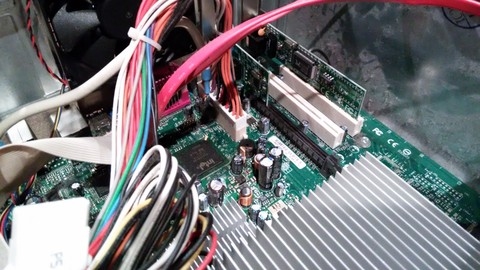Network security is a critical aspect of any modern IT infrastructure.
With the increasing prevalence of cyber threats, protecting your network from unauthorized access and malicious attacks is more important than ever.
pfSense, a powerful open-source firewall and router, provides a robust solution for securing your network perimeter.
By learning pfSense, you can gain the skills necessary to configure and manage a powerful firewall, protecting your valuable data and ensuring the integrity of your network.
Finding a comprehensive and practical pfSense course on Udemy can be a challenging task.
You’re searching for a course that covers the fundamentals, provides hands-on experience, and equips you with the knowledge to configure and manage pfSense effectively.
With a plethora of options available, it’s easy to feel overwhelmed and unsure where to begin your learning journey.
Based on our extensive review of pfSense courses on Udemy, we believe the pfSense Fundamentals - Secure Networks With pfSense Firewall course stands out as the best overall.
This course provides a comprehensive introduction to pfSense, guiding you through the installation, configuration, and management of this powerful firewall.
You’ll learn how to set up firewall rules, configure VPNs, implement intrusion detection systems, and much more.
However, this is just one of many excellent pfSense courses available on Udemy.
We’ve compiled a list of top recommendations, catering to various learning styles and experience levels.
Keep reading to discover the perfect pfSense course to bolster your network security skills!
pfSense Fundamentals - Secure Networks With pfSense Firewall
This course equips you with the knowledge and skills to secure networks using pfSense, a powerful open-source firewall.
You begin with the fundamentals of firewalls and then delve into pfSense, learning how to install it on a virtual machine using VirtualBox.
The course guides you through the initial setup, teaching you how to configure essential features such as SSH for remote access, managing DNS servers, and setting user access.
You master the art of creating firewall rules, controlling network traffic flow using techniques like whitelisting and blacklisting.
You explore pfBlockerNG, a robust tool within pfSense, to block undesirable traffic based on IP addresses and DNS blacklists.
The course further strengthens your security expertise by teaching you how to install, configure, and leverage Snort and Suricata, powerful intrusion detection and prevention systems, to safeguard your network.
The course then guides you through setting up a DMZ (Demilitarized Zone) — a secure network segment that isolates sensitive applications like web servers from the internal network.
You discover how to configure the firewall to isolate the DMZ, bolster its security with Snort, and manage access through SSH.
Finally, the course covers vital maintenance aspects of pfSense.
You learn to back up your configurations, ensuring recoverability.
You understand how to update pfSense, keeping your firewall current with the latest security patches and features.
Through practical examples and hands-on exercises, you become proficient in identifying and resolving common pfSense issues, solidifying your skills as a network security professional.
The pfSense Fundamentals Bootcamp 2023 Edition
This pfSense Fundamentals Bootcamp starts you off with the fundamentals.
You’ll begin by installing pfSense, a versatile firewall and router, in a risk-free virtual environment using VirtualBox.
The course guides you through setting up a virtual machine with Lubuntu, downloading, and configuring pfSense.
You’ll then learn how to install pfSense on a physical device, format a bootable USB drive, and configure your device.
You’ll then dive into essential pfSense functions like setting up a DHCP server to automatically assign IP addresses, configuring a DNS resolver for faster web browsing, and building advanced firewall rules to protect your network.
You’ll discover how to back up your pfSense configuration and restore it if necessary.
This bootcamp also covers more advanced features like OpenVPN, which lets you securely connect to your network from anywhere.
You’ll learn how to use DynDNS and NO-IP for dynamic DNS services, as well as how to set up your own OpenVPN server and clients.
The course also covers optional topics like configuring Squid proxy with ClamAV for content filtering and security, as well as configuring VLANs in pfSense to segment your network for increased security.
This course will provide you with the knowledge and skills necessary to manage and secure your network using pfSense.
It’s a hands-on training that covers the fundamentals of network administration using this robust open-source platform.
Mastering pfSense
This course takes you from pfSense newbie to confident network administrator.
You start with the basics: learning about hardware requirements and setting up your virtual lab environment using VirtualBox and Windows 10.
You then download, install, and configure pfSense on a virtual machine using WinRAR.
You then dive into the pfSense web interface, where you’ll master the dashboard and essential administrative tasks.
You will learn to manage users, configure your DHCP server for seamless network connectivity, and create a Captive Portal for secure network access.
You then explore the intricacies of firewall rules and NAT, crucial elements of network security and management.
You learn how to configure L2TP/IPSEC VPNs for secure remote network access.
The course then introduces you to pfSense’s package manager.
You will learn how to install and configure Squid and SquidGuard.
These tools empower you to filter web traffic, blocking unwanted websites and restricting access to specific online content.
Finally, you acquire essential maintenance skills: backing up, upgrading, and restoring your pfSense configuration.
This ensures your system remains secure and up-to-date.
pfSense for Beginners: Setup and Configure your own firewall
This course on pfSense starts by teaching you about firewalls and how pfSense works.
You will learn about different firewall components and how they protect your network.
You’ll then discover how to download pfSense and create a bootable USB drive, a crucial step in the installation process.
The course guides you on installing an extra network card, connecting your firewall to the internet and your local network.
The course then guides you through installing pfSense on your computer, ensuring your network is secure and manageable.
You’ll learn about DHCP and how it assigns IP addresses to your devices.
You’ll also learn how to test your setup and troubleshoot any issues.
The course teaches you how to set up pfSense within a virtual machine using VirtualBox, a safe environment to practice without affecting your actual network.
You’ll explore the pfSense interface, from the console options to the web-based wizard and the dashboard.
You’ll learn how to manage system settings such as the Cert-Manager, Package Manager, and User Management, which gives you control over certificates, software packages, and network access.
You’ll dive into configuring your firewall, learning about interfaces, aliases, and how to create custom firewall rules.
The course explores advanced features such as traffic shaping, which allows you to prioritize different types of traffic.
You’ll learn about status logs, an essential tool for network monitoring.
You’ll even explore pfSense’s Captive Portal, enabling you to create custom guest login pages and set up voucher-based access for controlled internet use.
Finally, you’ll learn to back up and restore your pfSense configuration and block websites using pre-defined lists or by creating custom domains.
Beginners Are Building Their Own Fortune500 Grade Firewalls!
This course teaches you the difference between a firewall and a router.
You will learn how PfSense works as both to protect your home or small business network.
The course shows you how to set up your own firewall even if you have a small budget.
You will learn how to create a bootable CD for installation with 7-Zip.
The course teaches you how to set up your network, install PfSense, and configure your settings.
It guides you step-by-step through installing PfSense on VirtualBox.
You will learn how to use the PfSense Wizard and WebConfigurator to manage the firewall settings.
This course teaches you about Network Address Translation (NAT), which allows your devices on the LAN to share one internet connection.
You discover how computers on the LAN translate website names like yahoo.com and google.com into IP addresses.
You also learn how your devices obtain IP addresses and other settings automatically.
pfSense 2.4.4 Open Source Firewall
This course begins with pfSense’s history and typical uses, then guides you through choosing the right hardware for your needs, providing a solid foundation for building a custom firewall.
You learn the ins and outs of installation, configuring your first firewall rules for immediate security.
The course then dives into configuring essential pfSense features such as Network Address Translation (NAT), Virtual Private Networks (VPNs), and traffic shaping for optimal network performance.
You acquire the ability to configure advanced firewall rules using IPsets, ACLs, and even create custom rules for very specific scenarios, preparing you for complex network environments.
You delve deeper, exploring advanced features like Multi-WAN support for redundancy, VLANs for network segmentation, and High Availability for uninterrupted service - all crucial for strengthening your network’s security and performance.
This course equips you with the expertise to become a proficient pfSense administrator.
Finally, you master the practical aspects of managing your pfSense system.
The course covers implementing captive portals for guest access, monitoring system performance using real-time graphs, creating backups for disaster recovery, generating reports for network analysis, and upgrading your pfSense firewall to benefit from the latest features and security patches.
This comprehensive approach ensures your long-term success in maintaining a secure and efficient network.
pfSense: Network Security and Firewall Management
This pfSense course will teach you how to set up and manage a powerful firewall for top-notch network security.
You will start with the fundamentals of networking, including IP addresses and DHCP, and then jump into the world of pfSense.
You will discover how to install pfSense on both virtual machines (using tools like Proxmox and VirtualBox) and physical hardware.
This dual approach allows you to practice in a safe virtual environment before implementing your skills on your actual network.
The course guides you through setting up network configurations, including configuring DHCP and DNS servers.
You will gain hands-on experience creating firewall rules, utilizing aliases for easier management, and scheduling rules for enhanced control.
The course delves into NAT and port forwarding, which are essential for controlling how network traffic flows in and out of your network.
You will learn to set up a secure OpenVPN server on your pfSense system and explore the integration of a PIA VPN service.
This allows extending VPN protection across your entire network for increased privacy and security.
You will also dive into VLANs, a powerful way to segment your network for improved security and efficiency.
The course doesn’t shy away from more advanced topics, either.
You will learn how to use iVentoy for PXE Boot DHCP configuration, which allows for automatic deployment of pfSense.
Finally, you will cover the crucial aspects of backing up your pfSense configuration and troubleshooting potential issues, ensuring the long-term stability and security of your network.
Pfsense on GNS3 for LABS Emulation
This course provides you with the tools to enhance your networking skills using Pfsense within a virtual environment created by GNS3.
You begin by learning how to download and install the necessary software, including GNS3 and the Pfsense image.
You then move on to building your virtual network, connecting Pfsense to both the internet and your local network (LAN).
This process teaches you how to configure Pfsense as the bridge between these two networks.
You discover the essentials of setting up and configuring LAN and WAN connections on Pfsense, gaining control over how your network interacts with the outside world.
You learn how to connect your Pfsense virtual machine to the internet and access it from your LAN.
This practical experience provides a clear understanding of how a Pfsense firewall connects to a network and how to configure its fundamental settings.
The instructor also provides a bonus lecture covering advanced Pfsense topics.
These additional tips and tricks help you unlock Pfsense’s full potential, delving into specific features and configuration examples.
This course equips you with a strong foundation in utilizing Pfsense within a virtual environment, preparing you for more advanced networking tasks in the future.








